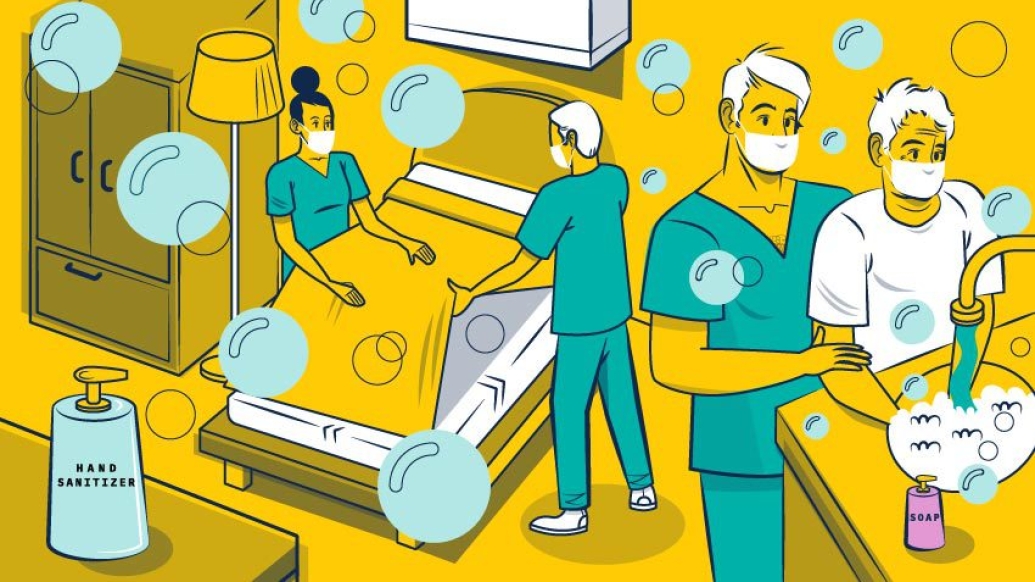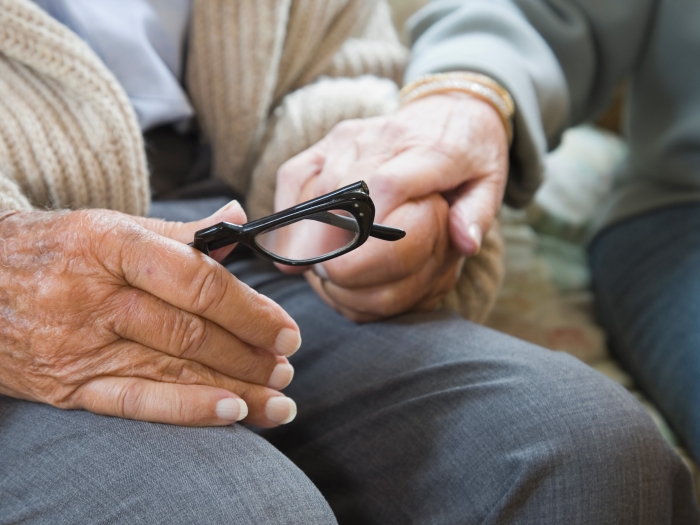As the pandemic shines a spotlight on the special vulnerability of such settings, new studies show importance of proper infection prevention efforts.
11:55 AM
Author |

More than 130,500 nursing home residents have died of COVID-19 since the pandemic arrived in the United States – 20% of all known American deaths.
More than a million of their fellow residents, and the staff who care for them, have gotten sick.
This high toll has focused a spotlight on the special vulnerability of such facilities to all kinds of infectious diseases that prey on older adults, people with serious health issues and recently hospitalized people.
Lona Mody, M.D., M.Sc., welcomes that spotlight, and the change it could bring.
She's glad to see policymakers, regulators, insurers and patient advocates press for better infection prevention in skilled nursing facilities, long-term acute care facilities, assisted living complexes and more.
Mody and her team at the University of Michigan and VA Ann Arbor Healthcare System have worked for nearly two decades to study the previously unglamorous topic of nursing home infection prevention.
They and several other teams across the nation have published dozens of studies documenting the special risks in residential care facilities, developing training programs for nursing home staff, and testing ways to reduce infections.
But until the pandemic, progress was hard won.
SEE ALSO: Proactivity and Partnership Pay Off for Nursing Homes in a Pandemic
"Prevention never really sells, but the devastation that COVID-19 has caused has finally brought the issue to the fore," said Mody, a geriatrician at Michigan Medicine, U-M's academic medical center and head of the Center for Research and Innovations In Special Populations focused on infection prevention for short-stay and long-term residents of nursing homes. "I'm glad that people are taking notice and looking at our prior work, and thinking about ways to extend it to their own care settings."
Many of the diseases her team studies don't have a vaccine to turn to, unlike COVID-19. But even as the vast majority of nursing home residents have now been vaccinated, public data shows that a much smaller percentage of nursing home staff have gotten the COVID vaccine. This raises the potential for breakthrough cases in residents as the highly infectious Delta variant tears through the country.
The pandemic also revealed the need for nursing homes to be included in pandemic planning by public health authorities, including supplies of personal protective equipment, Mody and colleagues recently wrote in another paper.
Focus on superbugs
The vaccine, plus masks, separation of COVID-positive patients into separate areas, better ventilation and better training of staff, have helped turn the tide in nursing homes for the moment, Mody says.
But that leaves plenty of other infection risks lurking in nursing homes, ready to be spread between patients, staff and visitors.
Take, for instance, the "superbugs."
MORE FROM THE LAB: Subscribe to our weekly newsletter
These bacteria, which have evolved resistance to multiple antibiotics because of the improper use of the drugs for decades, pose a deadly threat to the same nursing home residents who have fallen victim to COVID-19.
They're called multidrug resistant organisms, or MDROs, and can include fungi such as Candida auris as well as bacteria like MRSA, short for methicillin-resistant Staphylococcus aureus, VRE (vancomycin-resistant enterococcus) and a group called RGNB, for resistant Gram-negative bacteria.
"Even as COVID-19 gets more under control in nursing homes, these other infections are going nowhere," said Mody. "MDROs spread mostly by contact between people and the physical environment inside a nursing home. The approach to preventing their transmission is different from viral transmission."
SEE ALSO: Nursing Homes Cut UTIs in Half Through a Focused Effort on Catheter Care
In a new study published in JAMA Network Open, the team shows that a multi-pronged approach can reduce MDRO levels in a nursing home environment.
The randomized controlled trial, set in six nursing homes, involved 245 patients. Nearly all of them were short-stay patients who had been recently discharged from hospitals, but not yet ready to go home.
Prevention never really sells, but the devastation that COVID-19 has caused has finally brought the issue to the fore.Lona Mody, M.D., M.S.
Short-stay patients make up a growing sector of nursing home residents, but pose special challenges because they can arrive at the nursing home with MDROs on their hands and bodies from the hospital, and often have an intense schedule of physical therapy and occupational therapy that means they move about within the nursing home and touch a lot of surfaces. Mody's team has documented MDRO levels on both patient hands and nursing home rehab gym equipment.
In the three nursing homes that tried a multi-pronged approach to MDRO reduction, staff were asked to:
-
Use special precautions and personal protective equipment when caring for a patient with an open wound, catheter or feeding tube,
-
Use an antimicrobial liquid called chlorhexidine on the skin of at-risk patients after helping them shower,
-
Clean their hands and patients' hands more often,
-
Follow specific cleaning protocols and
-
Undergo additional infection prevention training.
The three nursing homes also conducted proactive surveillance to sample for the presence of MDROs.
In all, the patients' rooms in these three homes had a 43% lower chance of having MDROs present, compared with the three homes that didn't implement the new approach.
While the study didn't specifically look at any MDRO-related illness the patients might have experienced, "Patients and their care environment are linked in terms of MDROs. If the patient is positive for an MDRO on them, then the environments around them may be, and vice versa," Mody said.
Past research has shown that patients who come to nursing homes from hospitals, whether for a short stay before going home, or returning to their nursing home room after a health event, are more likely to have MDROs on them the longer their hospital stay was.
Like Podcasts? Add the Michigan Medicine News Break on iTunes, Google Podcasts or anywhere you listen to podcasts.
That's because the sicker they were, and the longer they were hospitalized, the more likely they were to lose immune system and physical function, and to receive antibiotics that can kill off other bacteria that could fight off MDROs. Targeted interventions are needed for these patients when they get to nursing homes, so that their MDROs do not spread to other residents – for instance, on the hands of staff or the physical therapy gym equipment. Mody's team has even reported on the presence of MDROs on the privacy curtains in patient rooms.
Focus on UTIs
Another key area of infection prevention in nursing homes is fending off urinary tract infections – a common problem given that many nursing home residents have incontinence and must wear absorptive products or use a catheter inserted into their ureter.
Both are breeding grounds for bacteria and catheters can carry infections further into the body. And UTIs can lead to behavior changes, especially in residents with memory or cognitive issues, as well as raising the risk of more serious infections and even sepsis.
A recent presentation by Mody's team at the annual meeting of the Association of Professionals in Infection Control and Epidemiology shared preliminary results from a three-year effort to prevent UTIs and catheter-associated UTIs in 55 nursing homes across Michigan. It builds on earlier evidence from a smaller study and a large national study showing that concerted efforts to prevent UTIs can have an impact on MDROs and patient infection rates.
The recently presented data show high rates of infection prevention policies, tracking of UTIs and reporting data to leadership, but suggest a need for more consistent training of staff, tracking of staff hand hygiene and PPE supplies, and use of methods to ensure catheters are used only when necessary.
More research needed
Mody and others in the field came together to write a white paper calling for more research on nursing home infection prevention, recently published by the Society for Healthcare Epidemiology of America.
The COVID-19 death toll in nursing homes, combined with other trends toward Americans' desire to "age in place" that preceded the pandemic, and potential policies to increase Medicare coverage of home-based caregiving, may change the role of these institutions, Mody said. But even so, millions of people live in nursing homes and other residential care facilities, even if some are only there for a few weeks. So, focusing on infection prevention will still be important.
Assisted living facilities are much less likely to be regulated by state licensing agencies, and are not subject to Medicare's public reporting or grading system. That makes them an important frontier for new focus on infection prevention, even though their residents are less seriously ill or disabled.
"All care settings should invest in safety for their residents, and teach residents and staff alike about good hand hygiene and other practices," Mody said. "Families can do more as well, by asking the right questions, offering to help, and being part of the solution."
Paper cited: "Effectiveness of a Multicomponent Intervention to Reduce Multidrug-Resistant Organisms in Nursing Homes," JAMA Netw Open. DOI: 10.1001/jamanetworkopen.2021.1655

Explore a variety of healthcare news & stories by visiting the Health Lab home page for more articles.

Department of Communication at Michigan Medicine
Want top health & research news weekly? Sign up for Health Lab’s newsletters today!





